Recent Water Damage Posts
Post-Restoration Home Maintenance: Preventing Future Damage
1/17/2024 (Permalink)
After experiencing a water damage event, it is crucial to address the issue immediately through professional restoration services like SERVPRO®. Once the restoration is complete, your home's condition and safety are restored, but preventive measures should be taken to prevent future damage. This blog will detail post-restoration home maintenance tips that will help prevent future water damage and protect your home.
Regular Inspection and Maintenance of Plumbing System
Your home's plumbing system is susceptible to wear and tear, resulting in leaks and water damage. Conduct regular inspections of pipes, valves, and appliances to ensure they are functioning adequately and promptly repair or replace aging or damaged components.
Excess moisture can cause mold growth, corrosion, and other water-related issues. Proper ventilation and dehumidification help to control the moisture levels in your home, reducing the risks of mold and other water damage issues.
Clean and Maintain Gutters
Gutters and downspouts play a crucial role in protecting your home by diverting water away from the foundation. Clean gutters regularly to prevent clogging, which can lead to water infiltration and potential damages.
Your home's roof can take a considerable beating from weather conditions and environmental factors. Regular roof inspections, repairs of leaks, and adequate insulation can prevent water intrusion and related issues like mold, rotting, and interior water damage.
Landscape and Drainage Management
Proper landscaping practices help prevent water damage to your home. Ensure that your drainage system effectively diverts water away from the home's foundation by directing water flow off the property, using downspout extensions and grading the landscape appropriately.
Conduct Regular Home Inspections
A regular home inspection by a professional can help identify potential issues before they become major water damage concerns. This is especially necessary when moving to a new home or after significant weather events. Faulty appliances and equipment like washing machines, dishwashers, and water heaters can lead to water damage if left unattended. Consequently, it is essential to conduct maintenance checks on appliances regularly.
Post-restoration home maintenance is critical to ensure your home stays safe and free from water damage. Diligently following these tips can prevent potential water damages, saving homeowners untold costs and peace of mind. Proper home maintenance is essential for ensuring the longevity and comfort of your home, making it crucial to prioritize water damage prevention.
Tips for Homeowners to Stay Safe During Water Damage Cleanup
10/16/2023 (Permalink)
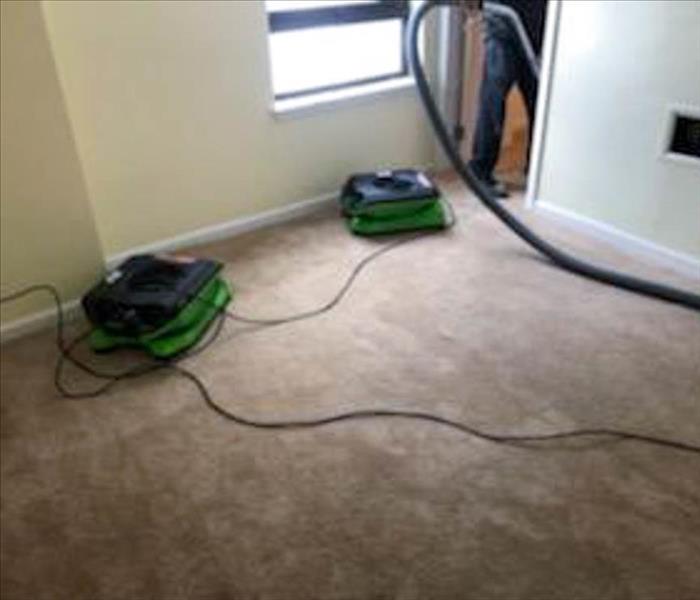 While minor water damage cleanup can often be handled by homeowners, many situations may require professional assistance.
While minor water damage cleanup can often be handled by homeowners, many situations may require professional assistance.
Water damage can be a stressful and disruptive event for homeowners. Whether it's a burst pipe, a flooded basement, or a roof leak, responding quickly and effectively is crucial to minimize damage and prevent long-term problems. However, in the midst of the cleanup process, it's essential to prioritize your safety. In this blog post, we will discuss important tips and precautions to protect yourself during water damage cleanup.
Personal Protective Equipment (PPE)
Before you begin the cleanup process, make sure you have the necessary personal protective equipment (PPE) to protect yourself from potential hazards. This may include waterproof gloves, protective eyewear, rubber boots, and a face mask. PPE will help shield you from contaminants in the water, such as bacteria, chemicals, and sewage, reducing the risk of health issues.
Disconnect All Power Sources
Water and electricity do not mix well. To avoid electrocution or other electrical hazards, it's crucial to disconnect all power sources in the affected area before starting the cleanup. This includes turning off the electricity at the main breaker or calling a professional electrician to ensure it is done safely. Never step into standing water if there is a risk of electrical appliances or outlets being submerged.
Identify Potential Hazards
Water damage can weaken structures, making them unstable. Before entering the affected area, conduct a thorough assessment of the surroundings to identify any potential structural issues, such as sagging ceilings, compromised floors, or crumbling walls. Additionally, be cautious about slippery surfaces caused by water, mud, or debris. Using sturdy and stable pathways, wearing non-slip footwear, and avoiding unstable areas can help prevent accidents and injuries.
Dispose of Contaminated Items
Water damage often results in the destruction of personal belongings and furniture. Depending on the level of contamination, some items may need to be properly disposed of to ensure your safety. Porous materials like carpets, padding, and upholstered furniture that have come into contact with black water or sewage should be discarded. Follow local regulations and guidelines for disposing of contaminated items to prevent risk.
Practice Proper Cleaning and Sanitization
Use EPA-approved disinfectants to thoroughly clean surfaces and prevent the growth of mold and bacteria. It's essential to clean not only visible areas but also hidden spaces, such as behind walls or under flooring, where moisture may have seeped. Proper ventilation with fans and dehumidifiers can help expedite the drying process and reduce the risk of mold growth.
Seek Professional Assistance
While minor water damage cleanup can often be handled by homeowners, certain situations may require professional assistance. If the water damage is extensive, contaminated with sewage, or poses a risk to your health and safety, it's best to call a reputable water damage restoration company. These professionals have the expertise, equipment, and experience to handle more complex restoration tasks, ensuring a thorough and safe cleanup process.
Water damage cleanup requires swift action, but it's essential to prioritize your safety throughout the process. By wearing appropriate personal protective equipment, disconnecting power sources, identifying potential hazards, properly disposing of contaminated items, practicing proper cleaning and sanitization, and seeking professional help when needed, you can protect yourself from potential dangers. Remember, your well-being is paramount during water damage cleanup, and taking the necessary precautions will help you navigate the process safely and effectively.
Water Dripping from Light Fixtures: Causes, Risks, and Solutions
7/27/2023 (Permalink)
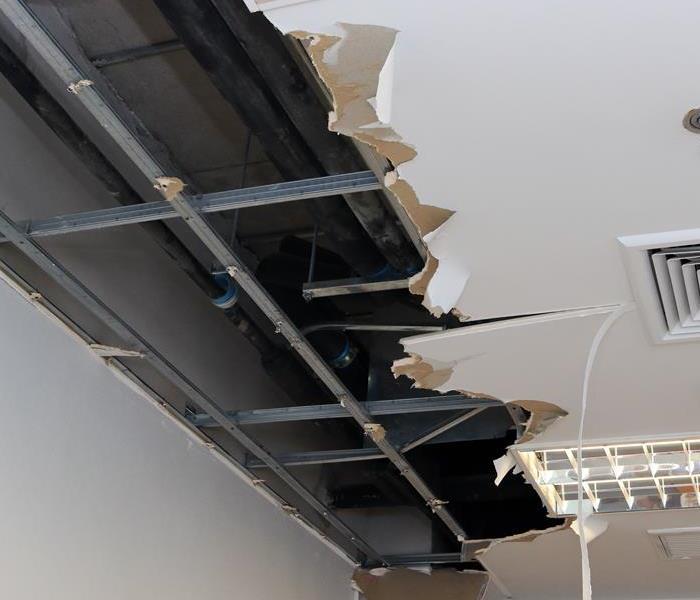 Water dripping from the ceiling can cause electrical and water damage to your property.
Water dripping from the ceiling can cause electrical and water damage to your property.
Water dripping from light fixtures can be a perplexing and potentially hazardous situation for homeowners. Not only does it pose a risk to your electrical system, but it also indicates an underlying issue that requires prompt attention. In this blog post, we will explore the possible causes of water dripping from light fixtures and provide actionable solutions to address the problem effectively.
Identify the Source
The first step in dealing with water dripping from light fixtures is to determine the source of the water. It could be due to various factors, including:
- Plumbing Leaks: A leaky pipe or plumbing fixture above the light fixture can cause water to seep through and drip onto the light.
- Roof Leaks: If your light fixture is located near the ceiling or on the top floor, a roof leak could be the culprit.
- Condensation: In some cases, condensation can form on pipes or HVAC ducts, leading to moisture accumulation and eventual dripping onto the light fixture.
Immediate Actions
If you notice water dripping from your light fixtures, take these immediate actions to mitigate any potential risks:
- Turn off the Power: As a safety precaution, turn off the electricity supply to the affected area from the circuit breaker.
- Place a Bucket or Container: Position a bucket or container under the light fixture to collect the dripping water and prevent further damage.
Addressing Plumbing Leaks
If the water source is identified as a plumbing leak, follow these steps:
- Call a Professional Plumber: It's essential to seek the assistance of a licensed plumber who can accurately locate and repair the leak to prevent further water damage.
- Temporary Measures: Until the plumber arrives, consider using temporary solutions like shutting off the water supply to the affected area or placing a bucket beneath the leak.
Dealing with Roof Leaks
If the water is entering through the roof, follow these guidelines:
- Contact a Roofing Professional: Engage a qualified roofing contractor to inspect and repair any roof leaks promptly.
- Mitigate Interior Damage: In the meantime, protect your home by covering furniture and floors with tarps or plastic sheets to prevent further water damage.
Managing Condensation Issues
In case condensation is the root cause, take these steps to address the problem:
- Insulate Pipes and Ducts: Apply insulation to pipes and HVAC ducts to prevent condensation from forming and dripping onto the light fixture.
- Improve Ventilation: Ensure proper airflow in your home by using exhaust fans, opening windows, or installing a dehumidifier to minimize excess moisture.
Water dripping from light fixtures demands swift action to safeguard your home and prevent potential electrical hazards. By identifying the source and following the appropriate steps, you can address the issue effectively. However, it is crucial to consult professionals for complex repairs and to ensure long-term solutions. Remember, timely intervention will not only protect your home but also provide peace of mind.
What do I do if my basement floods?
3/18/2023 (Permalink)
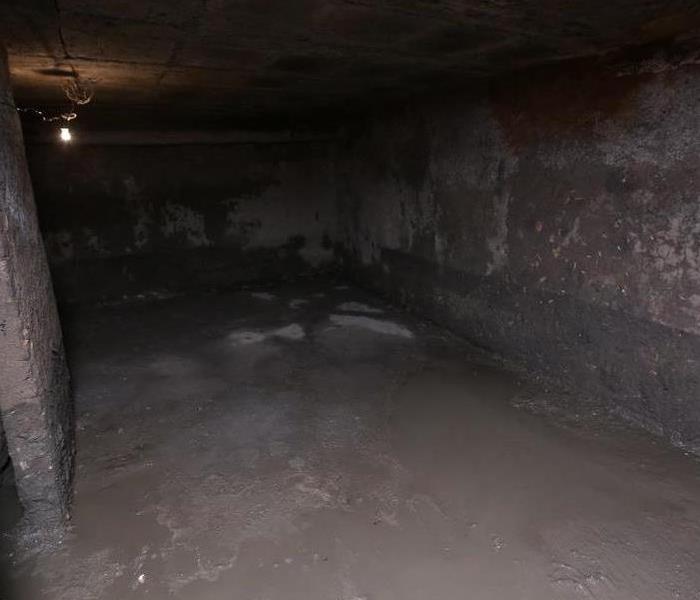 Flooded basement can leave you feeling hopeless, give SERVPRO a call today!
Flooded basement can leave you feeling hopeless, give SERVPRO a call today!
The last thing you want is to wake up one morning and find your home flooded. Rain-driven water can do massive amounts of damage, not only to your basement but also throughout the structure. That's why it's important to know what steps to take if this happens to you. Here is what you need to know about dealing with flooding.
Repair Replacement
If your basement has been flooded, your insurer will cover the cost of repair or replacement as well as any other damage that occurred because of flooding.
In order to make sure you're covered in case of a flood, talk to your insurance agent about adding a rider to your policy. A rider is something added onto an existing contract and can vary depending on how much coverage you want or need.
Flood Coverage
You can also lower your premium by making a few simple changes to your policy. For example, adding flood and wind coverage to your current homeowner's insurance policy could bring down the cost of your monthly premiums or even make them go away entirely. Another way to save money is by installing flood sensors in areas where flooding is likely, like basements and garages and then informing your insurance company about them so they know how much water damage has been prevented.
If you're willing to make some investments in preparation for disasters, there are additional discounts available for things like backup generators or batteries which can keep power flowing after an outage. Elevated pump systems help prevent basement flooding, and other mitigation measures such as sandbags or sump pumps that can help protect against rising floodwaters.
If you are willing to invest in these mitigation measures, some insurers offer discounts on premiums if you are willing to install an elevated pump system or other mitigation measures like backup generators and batteries. Avoiding this type of loss is important because it can cost thousands or even tens of thousands of dollars in repairs and replacements.
Prevent Basement flooding
The first step to avoiding water damage is to make sure that your basement is properly sealed. If you have a cracked foundation, then you should have it repaired immediately by a contractor who specializes in repairing foundations.
It is also important to keep an eye on the outside of your home for signs of water infiltration, such as muddy footprints around doors or windowsills. If you see any evidence of this at all, call an expert immediately!
If your basement has been flooded, your insurer will cover the cost of repair or replacement as well as any other damage that occurred because of flooding. Call the professionals at SERVPRO for your basement water damage. We are available anytime day or night.
What To Do If My Roof Leaks
1/23/2023 (Permalink)
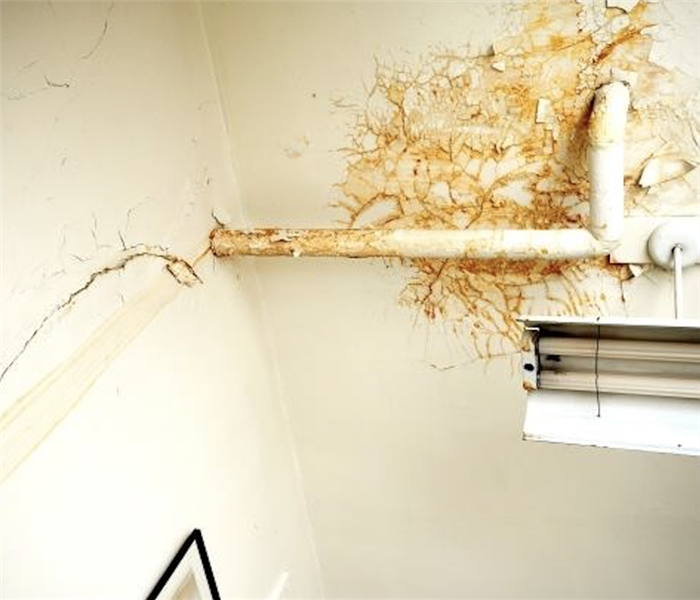 It can be scary to think about a leaky roof, but it’s important to stay calm and know that there are steps you can take to fix the problem.
It can be scary to think about a leaky roof, but it’s important to stay calm and know that there are steps you can take to fix the problem.
If your roof is leaking, you need to act fast. Not only will leaks damage your home and belongings, but they can also cause mold and mildew. It is important to call a professional cleanup and restoration company as quickly as possible after noticing a roof leak. Until the crew arrives, here are some things you can do.
Turn off electricity
If you have a leak, it's best to turn off your electricity. Turning off the electricity is important because electricity could cause an electric shock when trying to clean up water. Turning off the electricity will also prevent further damage until you can call a highly trained and experienced water cleanup professional.
Locate the source of the leak
It's important to determine where the water is coming from before you can fix it. To find sources of water in your home:
- Look for stains on ceilings or walls where there shouldn't be any (this could indicate a leak somewhere above)
- Feel around along cracks in ceilings and walls; if they feel slimy or wet, there might be moisture trapped in them (this could also indicate mold growth)
Contain the leaking water
If water is leaking through your roof, you'll need to act quickly. If the leak is minor, you might be able to contain it with a bucket or other container that can hold the amount of water coming down. This will help keep damage limited and prevent mold from developing on nearby surfaces like walls and floors.
If the leak is severe, however—or if it's too late to save your belongings—you'll want to call a professional as soon as possible. They have experience in fixing leaks and will know how best to approach this situation while protecting your home at all costs.
Remove any valuables
It's not just a matter of fixing the leak, you may also have to get rid of any valuables that may be damaged due to water. This is especially true if your valuables are not water resistant or waterproof or watertight, which means they can't handle being exposed to water for long periods of time. To prevent irreversible damage to your belongings, it is important to move your valuables to a safe location as quickly as possible after noticing a leak.
File an insurance claim
You should file an insurance claim with your insurance company. Documenting the damage is important, especially if there are multiple leaks or the damage is significant. Some restoration companies that you hire, such as SERVPRO, will also deal with the claims process for you.
Get it fixed right away
It can be scary to think about a leaky roof, but it’s important to stay calm and know that there are steps you can take to fix the problem. If your roof is leaking, make sure you get it fixed right away! Don't wait until the roof leaks again and don't try to fix it yourself. Disaster restoration companies, such as SERVPRO of Englewood/East Littleton are trained to handle the cleanup and restoration following a roof leak.
FAQ: Frozen Pipes and Insurance
1/18/2023 (Permalink)
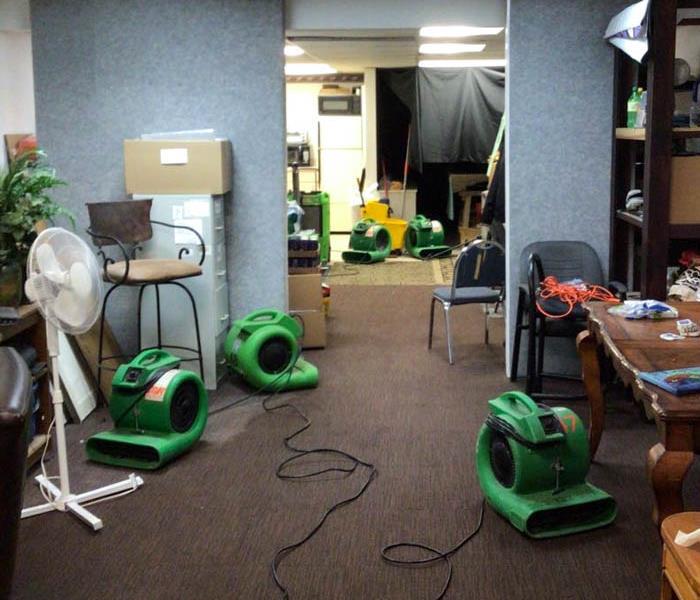 If you experience a burst pipe in your home or business, give SERVPRO of Englewood/East Littleton.
If you experience a burst pipe in your home or business, give SERVPRO of Englewood/East Littleton.
Winter can be a tough time for homeowners, especially if you have frozen pipes. There are a few ways to prevent burst pipes from happening, but sometimes they still happen. If your pipe bursts and causes damage inside your home, does the homeowner's insurance cover the cost of repairs? The answer is: it depends.
How do you prevent pipe-bursts?
The best way to prevent frozen pipes is by making sure that the temperature in your home doesn't drop below 55 degrees Fahrenheit at all times throughout the winter. You also need to consider how much water flows through each pipe and make sure you have enough insulation if it's exposed or above ground level.
Why do pipes burst?
When pipes burst from freezing temperatures, it's because they are unable to handle the pressure of expanding water. When water freezes, it expands. It doesn't have enough room to expand inside the pipe and will instead push on its walls until something gives way.
If your pipes burst in an unheated area of your home (like a basement), this causes a lot of damage as well: firstly because there's no insulation outside the walls or ceiling; secondly, because cold air tends to fall downwards and so if you're unlucky enough for your burst pipe to be in an unheated part of your house, it can cause serious damage underneath floors or other parts of your home.
When are frozen pipes covered?
Insurance companies will generally cover any damage from frozen pipes as long as it's considered "sudden and accidental." If a problem with your heating system causes a pipe to burst in your house while you’re away, it's likely covered by insurance.
If it is clear that the policyholder/property owner has neglected to protect their plumbing or other parts of their property, the insurance company might deny coverage.
What if I don't have insurance?
If you have no insurance and your home is damaged by a burst pipe, the cost of repairs can be significant. In this case, you may have to pay for repairs out of pocket.
If you have a frozen pipe, it's important to know that your homeowner's or renter's insurance might cover the damage. The key is to contact your insurer quickly after the pipe has burst, so they can assess the situation and determine if they'll help pay for repairs. If you're unsure about what type of policy you have with this company, ask them directly before making any decisions.
If you experience a burst pipe in your home or business, give SERVPRO of Englewood/East Littleton a call, and we will get your Englewood home back to normal as quickly as possible!
How to Prevent Pipes from Freezing
11/14/2022 (Permalink)
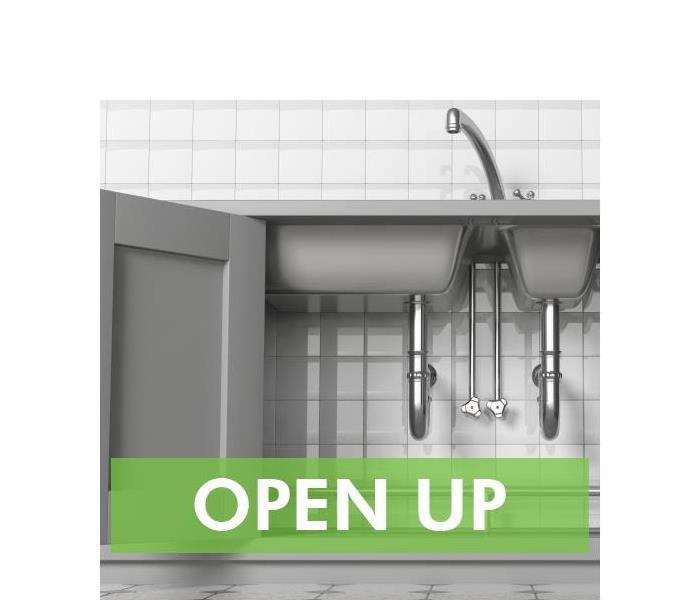 Keep cabinet doors open to allow heat to circulate throughout your home
Keep cabinet doors open to allow heat to circulate throughout your home
Keeping Pipes from Freezing: How to Avoid It
Winter is harsh and unforgiving. It's cold, it's wet, and if you're not careful, it can freeze your pipes. If you haven't already experienced this horror firsthand, chances are someone you know has!
Prepare For The Cold
To prevent pipes from freezing, you must prepare for the cold weather. In the winter months, you should turn down your thermostat to make sure it doesn't get too cold inside your home. Also, keep cabinet doors open to allow heat to circulate throughout your home and leave windows open when possible. It is also a good idea to leave a trickle of water running in the faucet so that it will never completely freeze over.
If you do have frozen pipes, there are several ways to thaw them. One way is to wrap the pipe with a towel or blanket and then turn on a hot water tap in your home. This will slowly warm up the frozen area, which can then be used for water again. The other method involves using a heat gun or hair dryer to warm up the area of your home where your pipes are located.
Let The Faucets Drip
You can prevent pipes from freezing by letting the water drip slowly. If your home has a faucet with a single-lever handle, turn it all the way open and let the water run into a bucket or another container. If your home has two shutoff valves (one for hot and one for cold), switch both levers to their off positions first, then take them off and allow any remaining water to drain out of each pipe before reconnecting them.
Once you've switched off your main valve, open cabinet doors under sinks so that if ice does indeed form inside a pipe, it is more likely to melt due to heat generated by running water at other locations within your house.
Leave Cabinet Doors Open
Leaving cabinet doors open allows you to keep the pipes from freezing. Make sure they are in a room that stays warm and not prone to moisture. If your crawl space has ventilation, make sure it’s clear of snow or ice so air can circulate.
If you have a crawl space that’s prone to moisture or flooding, it may be time to consider getting some help from a professional. They can install drainage systems, ventilation fans and other improvements that will keep your crawl space from becoming a dangerous place.
These Tips Will Help Prevent Frozen Pipes
Freezing pipes is a common problem in homes across the country. To keep it from happening to you, follow these tips:
- Make sure there’s a heat source in your home. If possible, have both an electrical heater (space heater) and a gas-powered one available to use during cold weather. Turn on the heater whenever you leave the house or go to bed at night, so it can warm up while you sleep.
- Use a humidifier that runs on electricity only during times when pipes may freeze up if they’re exposed to low humidity levels too long while they're turned off; this is especially important if your home doesn't have central heating or A/C systems installed yet (or if your home doesn't have any heating system at all).
So, there you have it—five tips to help your pipes from freezing during the winter. While these methods won’t always work, they will reduce the risk of your faucet or toilet freezing in extreme temperatures. If you take care of your home now, before frosty weather hits, then you’ll be prepared when temperatures drop and pipes freeze.
Watch For the Hidden Signs of a Leaky Bathtub or Shower
7/30/2022 (Permalink)
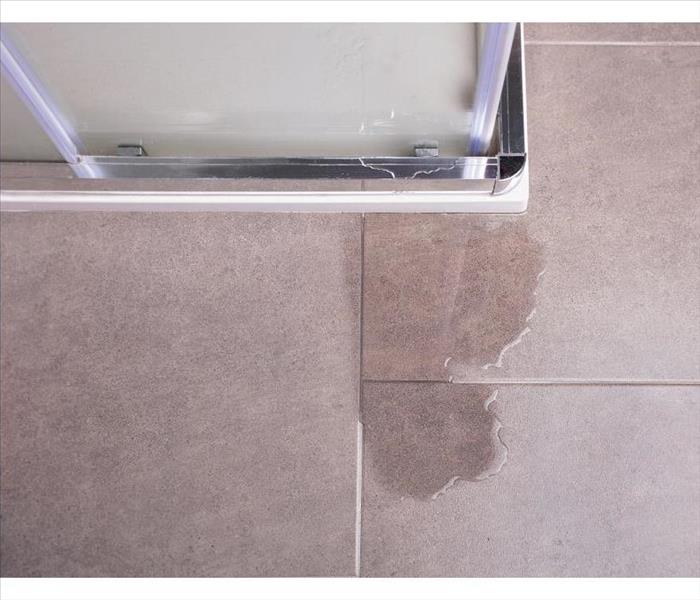 Shower pan leak
Shower pan leak
If you are like many citizens of Littleton, CO, you love to take a relaxing bath or shower. If you have a leak, however, your otherwise calming bath could turn into a nightmare. Fortunately, you do not have to wait for a shower or bathtub leak to sneak up on you.
Understanding the Consequences of a Bathroom Leak
As you probably know, bathroom leaks can cause a mess. You may not realize, though, that leaks often contribute to extensive damage inside your home. Specifically, following a bath or shower pan leak, you may notice damage to the following areas:
- Tile
- Drywall
- Fixtures
- Subflooring
- Paint
- HVAC systems
Finding Hidden Bathroom Leaks
When there is water on the bathroom floor, a leak can be easy to identify. Hidden leaks, however, often take weeks, months or longer to show themselves. As such, you must watch for some warning signs to know you may have water in place it isn’t supposed to be. Specifically, keep an eye out for the following:
- Mold growth
- Musty odors
- Floor weakness
- Stains
You may also not realize you have a shower or bathtub leak until you open your monthly utility bills. If your water bill spikes despite normal usage, you could have a hidden water leak somewhere in your home.
Repairing Water Damage
If you catch a bathroom leak immediately, you may only need to stop the leak and wipe up excess water. For leaks that last more than a few hours, however, damage may be extensive. To be certain your bathroom returns to its pre-leak condition, consider working with an experienced flood-mitigation technician. Specialists have the knowledge and equipment to identify leaks, clean belongings and repair damage.
You don’t want to ignore a shower or bathtub leak. While finding hidden leaks can be challenging, watching for their warning signs is usually worth the effort. With a bit of work, you can likely repair leaking fixtures and mitigate water damage.
How To Prevent Basement Floods
6/16/2022 (Permalink)
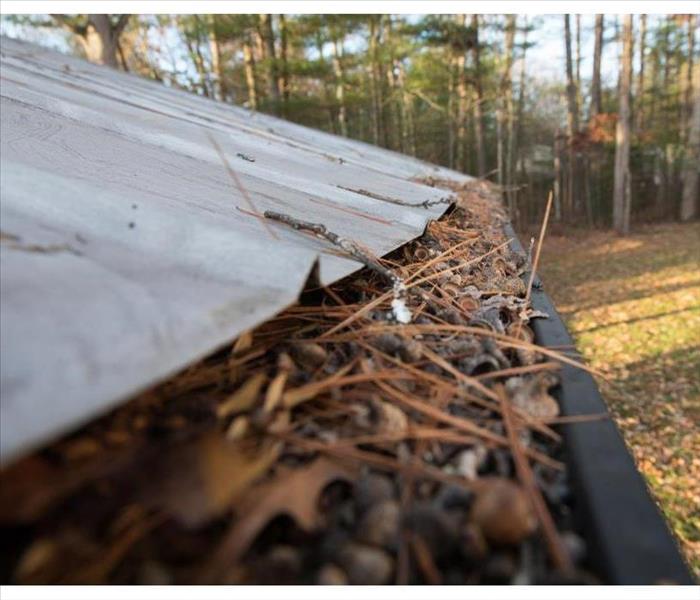 Leaves on your gutter can cause an overflow of liquid and a flooded basement.
Leaves on your gutter can cause an overflow of liquid and a flooded basement.
Five Causes of Basement Floods
A basement flood can cause severe harm to your house and necessitate water damage cleanup services. Luckily, there are some things you can do to limit this type of loss. Here are five common causes of basement floods and how to prevent them.
1. Clogs
Your property likely has a manifold that connects your house to the local sewer system. If the manifold clogs, your property could flood. The water could even destroy the foundation of your home. If you suspect there is a blockage in the gutter system, contact authorities in Centennial, CO, right away.
2. Poor Drainage
Ideally, the downspouts of your drainage system should be more than six feet away from the basement. They also should drain away from the basement rather than toward it. If necessary, have a plumber fix the downspouts so any excess water flows into your yard or the street.
3. Improper Home Location
Even just the site of your house can cause a basement flood. Homes are supposed to be constructed on a slope so water can drain properly. However, if your property is at the bottom of a hill, the fluid could flow right into your basement. Luckily, you do not have to move to solve this problem. Erosion should level any slopes near your house over time.
4. Blocked Roof Gutters
The gutters on your roof can fill with debris. Leaves and snow may block rainwater, causing an overflow of liquid and a flooded basement. You should thus make sure your eavestroughs are cleaned regularly. If the gutters still get clogged, consider purchasing larger gutters that can better handle local storms.
5. Poor Sealing
Water can seep through gaps between the tiles and create a basement flood. Have the seals checked regularly and fix them if necessary.
By properly maintaining your home's gutters, you can reduce the number of floods in your basement. You may also want to contact local professionals who can fix your drainage system or remove major clogs in your pipes.
Does Your Commercial Building Have These 4 Common Problems?
3/7/2022 (Permalink)
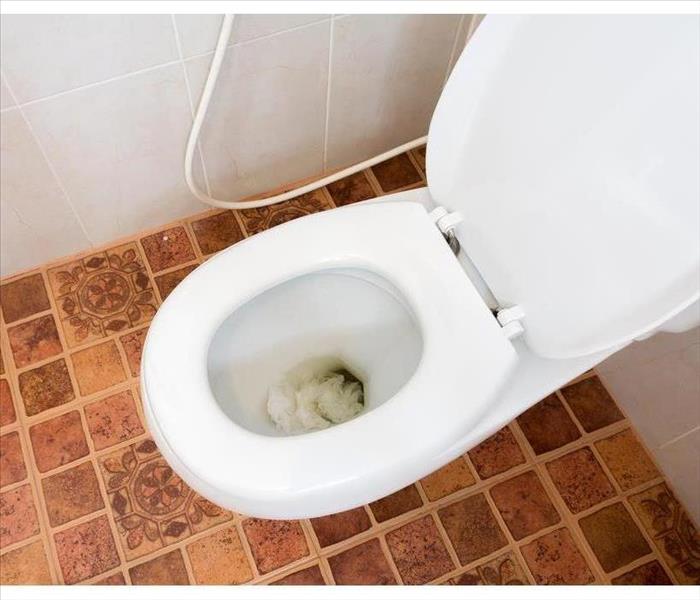 Clogs occur when the wrong items are flushed down the toilet.
Clogs occur when the wrong items are flushed down the toilet.
Do You Have These 4 Common Issues in Your Commercial Building?
Think about the last time you had your business plumbing inspected. For most buildings, the answer can be years. Considering you should have your plumbing inspected every 6 months, this is not a good thing. Regular inspections can help catch common issues like a blocked sewer line before they become serious problems. Here are some other common problems that occur in commercial buildings.
1. Leaking Toilets
While a blocked sewer line may seem like the worst possible option, leaking toilets can actually be a lot worse. One leak can waste thousands of gallons of water per year. Whether the leak is due to a problem with the handle or the flapper, it can go undetected for a long time because any extra water will be flushed down the drain. Therefore, it is important to have your toilets checked by a plumber regularly.
2. Low Water Pressure
Another thing that is worse than blocked sewer lines is low water pressure. The most common reason you experience pressure problems is a lot of small leaks in your water line. Each leak in your system lets out a little bit of water and reduces the pressure that comes out of your faucets. This is inconvenient, and it can do tons of damage and require a water restoration company.
3. Clogged Toilets
Clogs happen when improper objects are flushed down your toilets. For large buildings, it is important to inform your employees what can't be flushed. Forbidden items include wet wipes and tissues. In fact, pretty much anything that isn't waste or toilet paper will get stuck inside your pipes. If this happens, you will experience a toilet overflow.
4. Clogged Parking Lot Drains
Sometimes, the parking lots in Centennial, CO, back up after heavy rains. This usually happens because the parking lot drains are clogged with leaves, trash, and branches. Make sure to clear these away from drains so water can flow out of your lot and into the sewer system.
It is important to have your building regularly inspected to check for these common issues. If left untreated, pipe breaks and other problems will only become worse.
Four Steps to Take When Filing a Water Damage Claim
2/21/2022 (Permalink)
 Whether a pipe burst in your home or the water damage has come from another source, it is important that you begin the claims process right away.
Whether a pipe burst in your home or the water damage has come from another source, it is important that you begin the claims process right away.
When Filing A Water Damage Claim, There Are Four Steps To Follow.
Experiencing water damage in your Littleton, CO home can be a stressful situation. Filing an insurance claim can add to the frustration you are feeling, if you are unprepared. Following these steps can make the process go more easily for you.
1. Call Your Insurance Agent
The first thing that you should do is relocate to a safe area if the damage to your home is significant. After this, call your insurance agent. Getting in touch with your insurance company as soon as possible will allow the process to be started more quickly. It also prevents the company from denying your claim because you waited too long to report the damage.
2. Take Pictures of the Damage
Before you begin moving anything, you should take pictures. This will help during the insurance claim process because you will be able to show your agent the extent of the damage to your home. Be sure to include photos of the structure of your home as well as any damaged property and belongings.
3. Take Steps to Prevent Further Damage
If there is a flood of water in your home, your insurance company will expect you to take care of your house and do what you can to reduce any further damage. If they find that you have not done so, it may affect your claim.
4. Make a List of Lost Items
In order to file your insurance claim and be properly reimbursed, you will need to supply your insurance agent with a list of items that have been damaged. A professional remediation service can help in this area by determining which items can be salvaged and which must be replaced.
Whether a pipe burst in your home or the water damage has come from another source, it is important that you begin the claims process right away. Waiting too long can add unnecessary complications and might result in a lower amount of financial compensation.


 24/7 Emergency Service
24/7 Emergency Service









